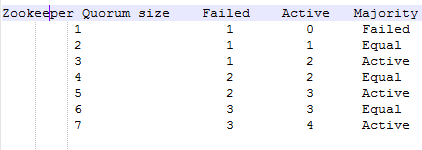From the ZooKeeper FAQ:
Reliability:
A single ZooKeeper server (standalone) is essentially a coordinator with
no reliability (a single serving node failure brings down the ZK service).
A 3 server ensemble (you need to jump to 3 and not 2 because ZK works
based on simple majority voting) allows for a single server to fail and
the service will still be available.
So if you want reliability go with at least 3. We typically recommend
having 5 servers in "online" production serving environments. This allows
you to take 1 server out of service (say planned maintenance) and still
be able to sustain an unexpected outage of one of the remaining servers
w/o interruption of the service.
With a 3-server ensemble, if one server is taken out of rotation and one server has an unexpected outage, then there is still one remaining server that should ensure no interruption of service. Then why the need for 5 servers? Or is it more than just interruption of service that is being considered?
Update:
Thanks to @sbridges for pointing out that it has to do with maintaining a quorum. And the way that ZK defines a quorum is ceil(N/2) where N is the original number in the ensemble (and not just the currently available set).
Now, a google search for ZK quorum finds this in the HBase book chapter on ZK:
In ZooKeeper, an even number of peers is supported, but it is normally not used because an even sized ensemble requires, proportionally, more peers to form a quorum than an odd sized ensemble requires. For example, an ensemble with 4 peers requires 3 to form a quorum, while an ensemble with 5 also requires 3 to form a quorum. Thus, an ensemble of 5 allows 2 peers to fail and still maintain quorum, and thus is more fault tolerant than the ensemble of 4, which allows only 1 down peer.
And this paraphrasing of Wikipedia in Edward J. Yoon's blog:
Ordinarily, this is a majority of the people expected to be there, although many bodies may have a lower or higher quorum.

